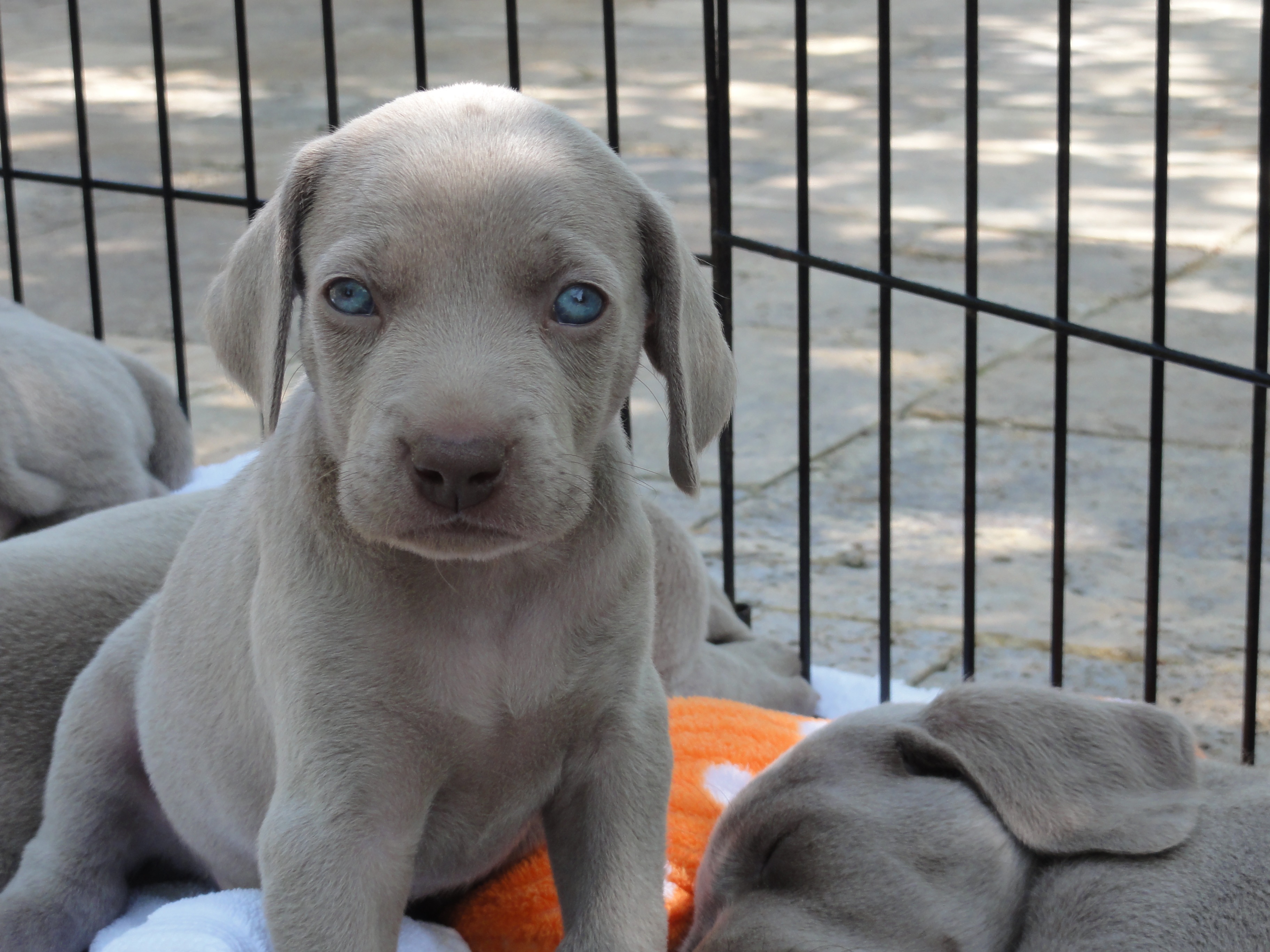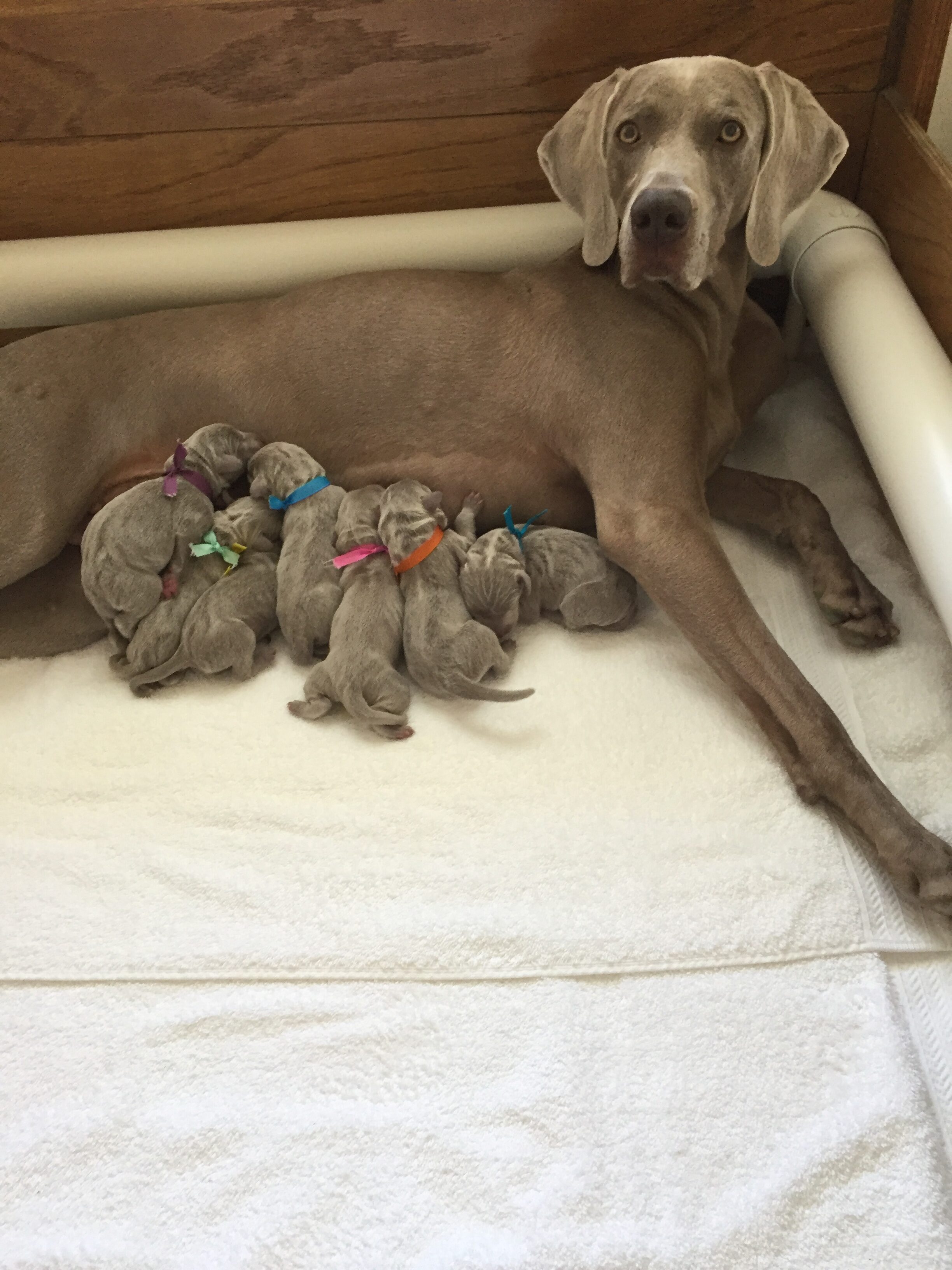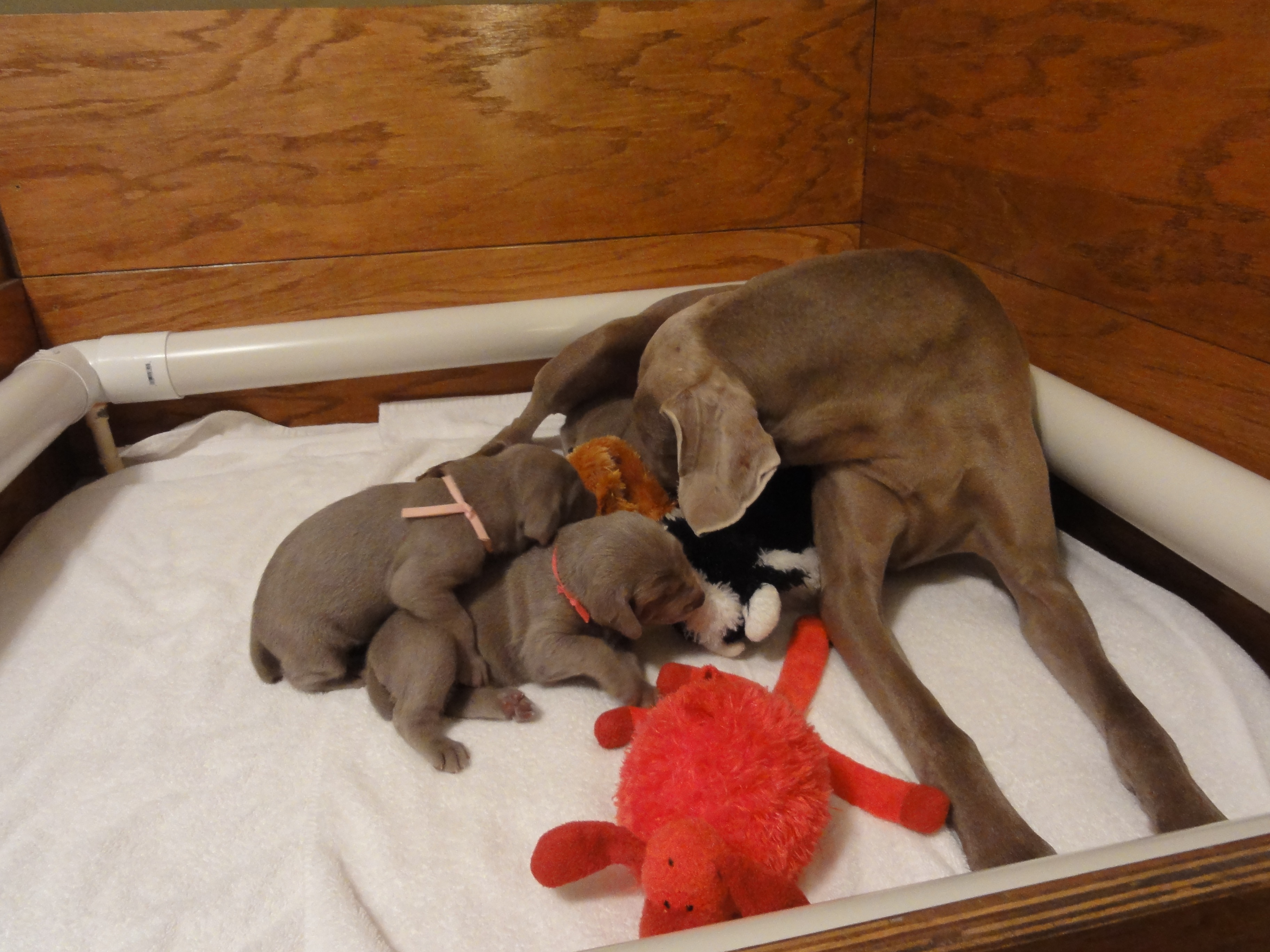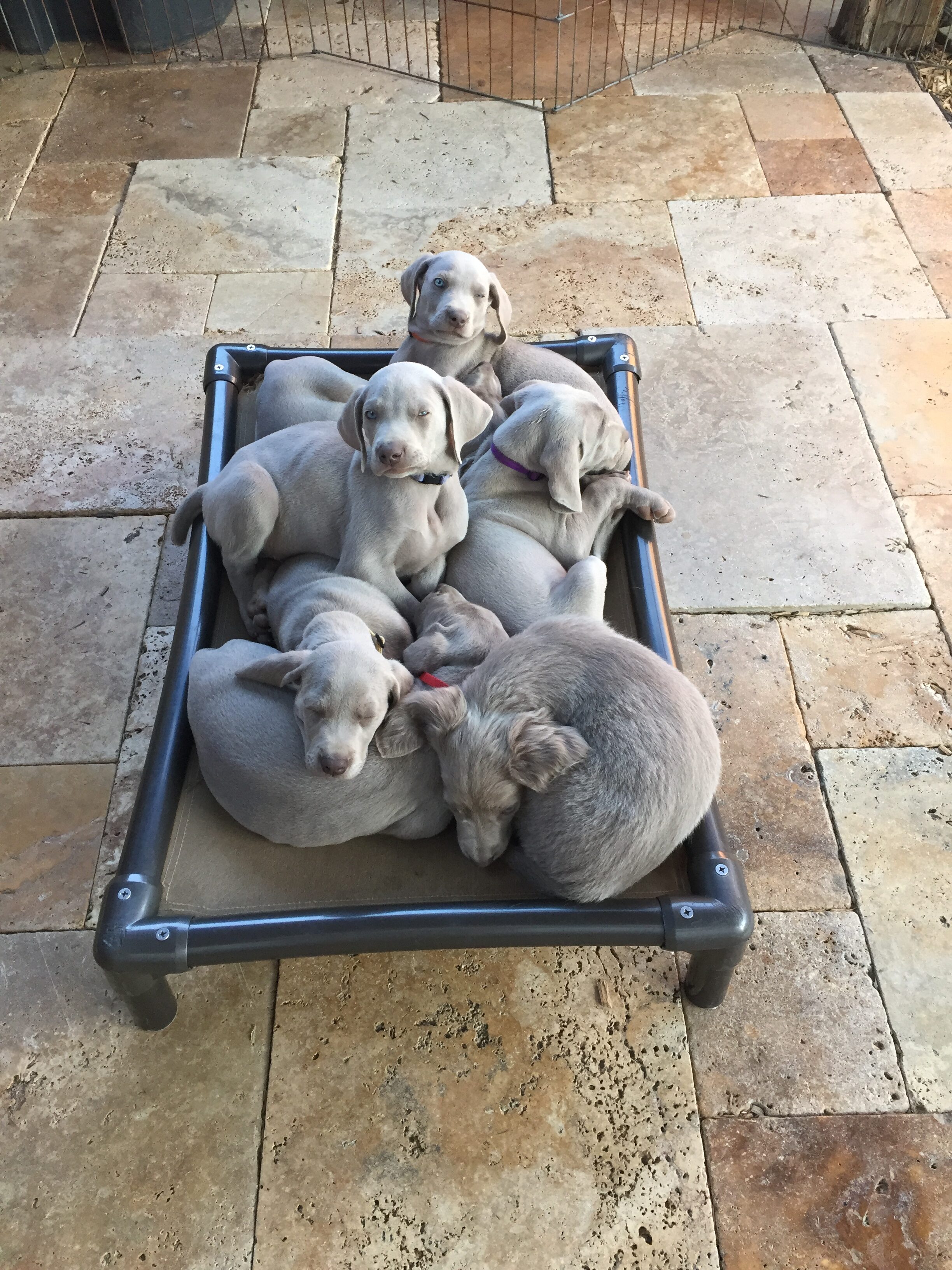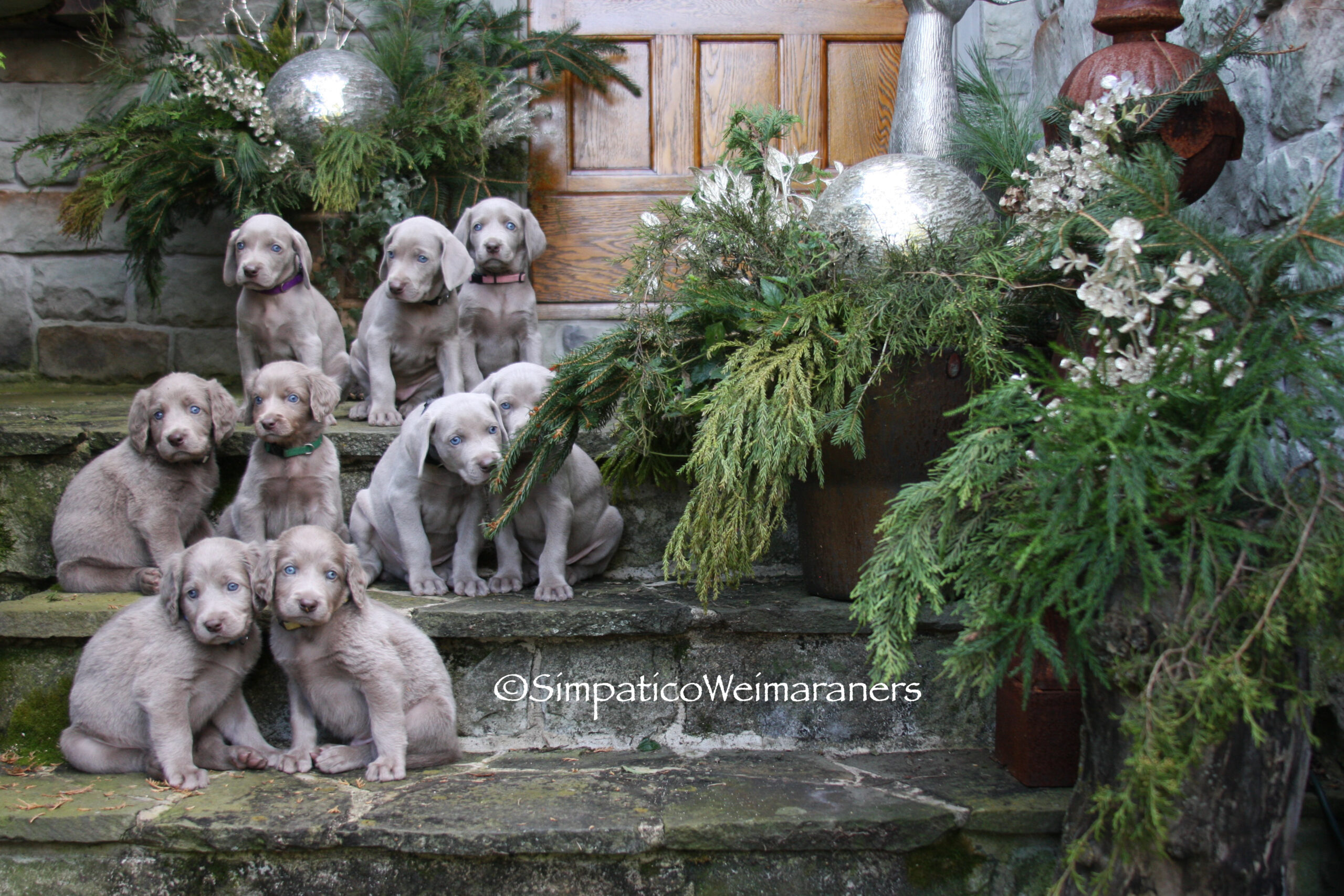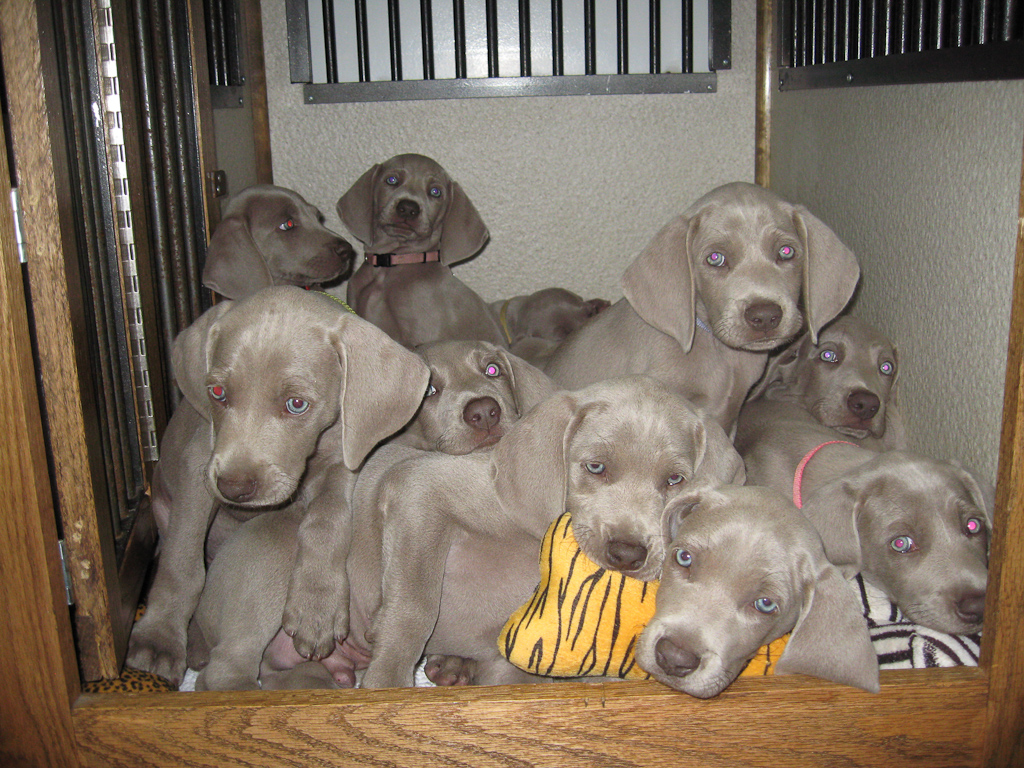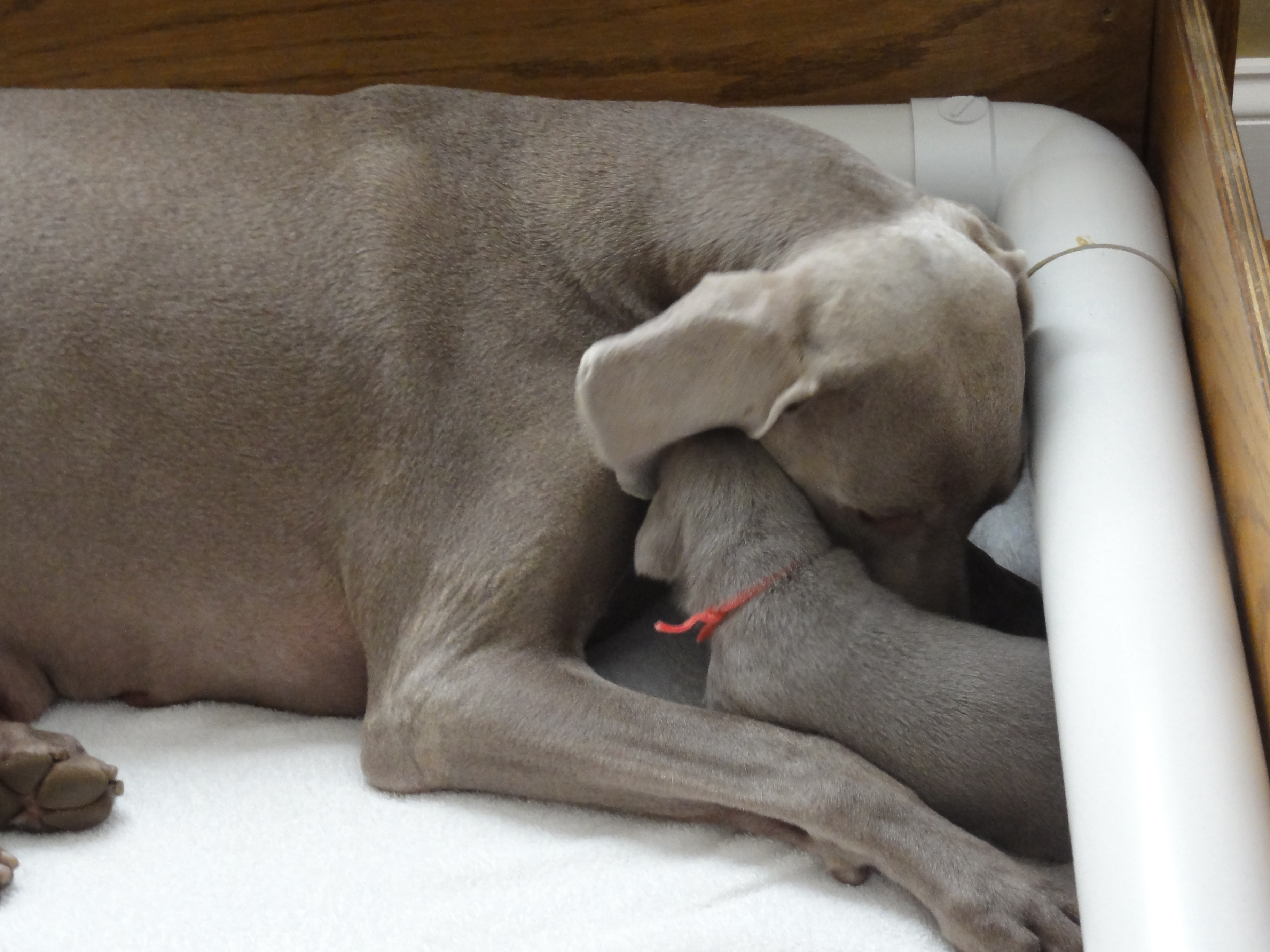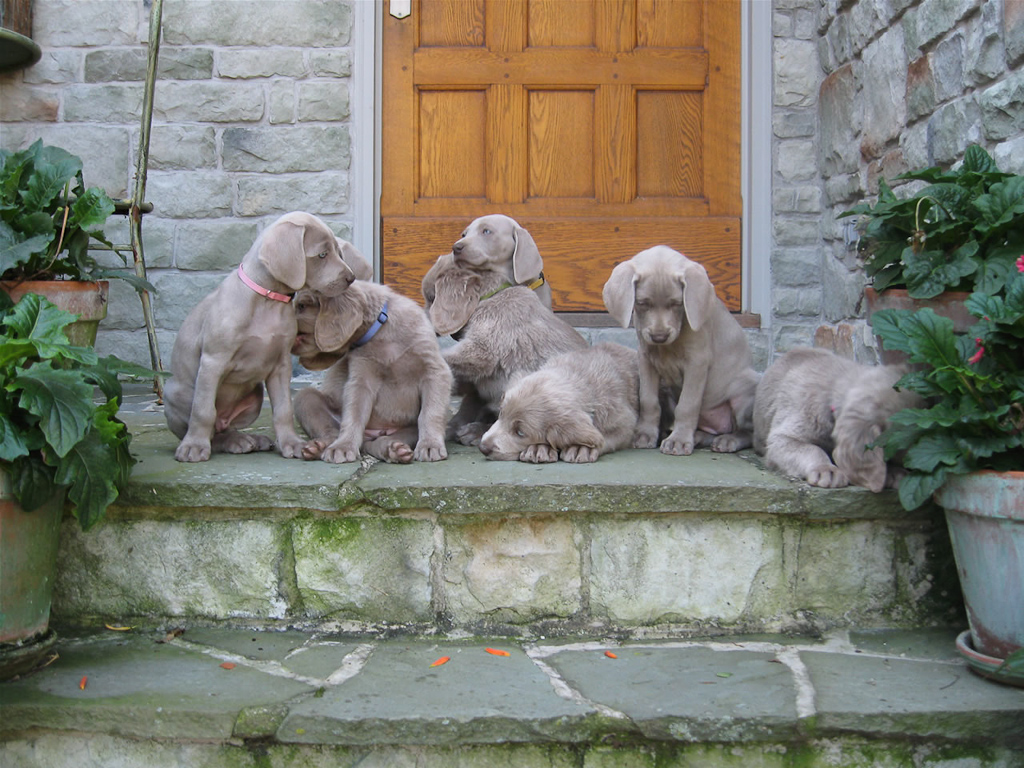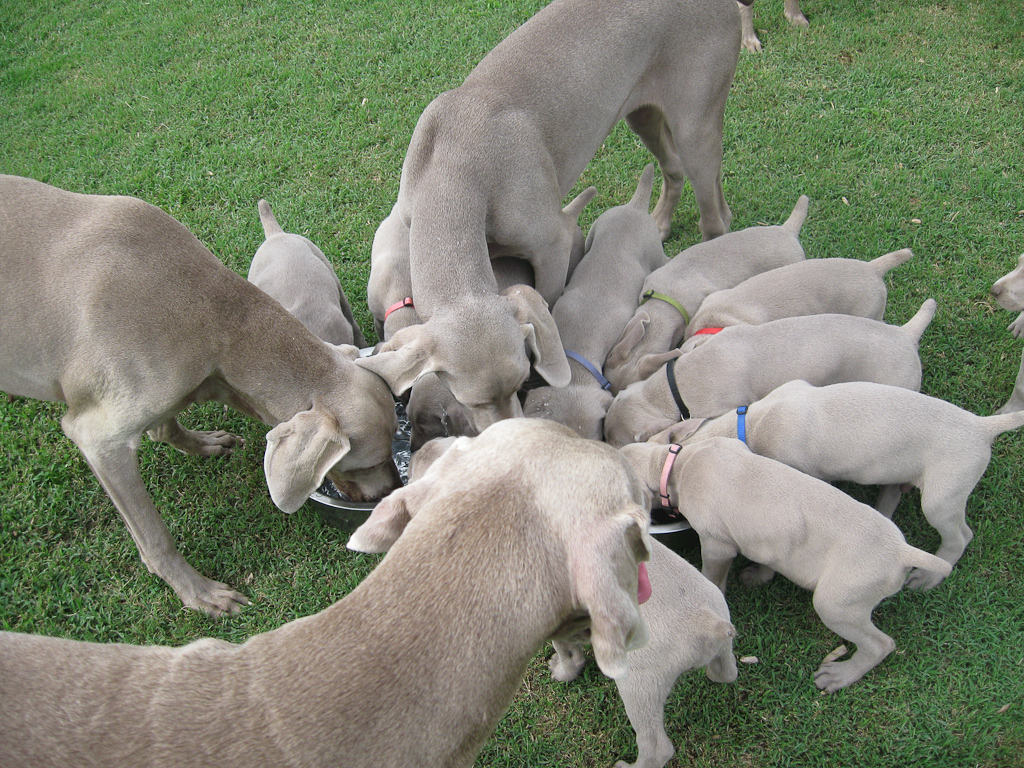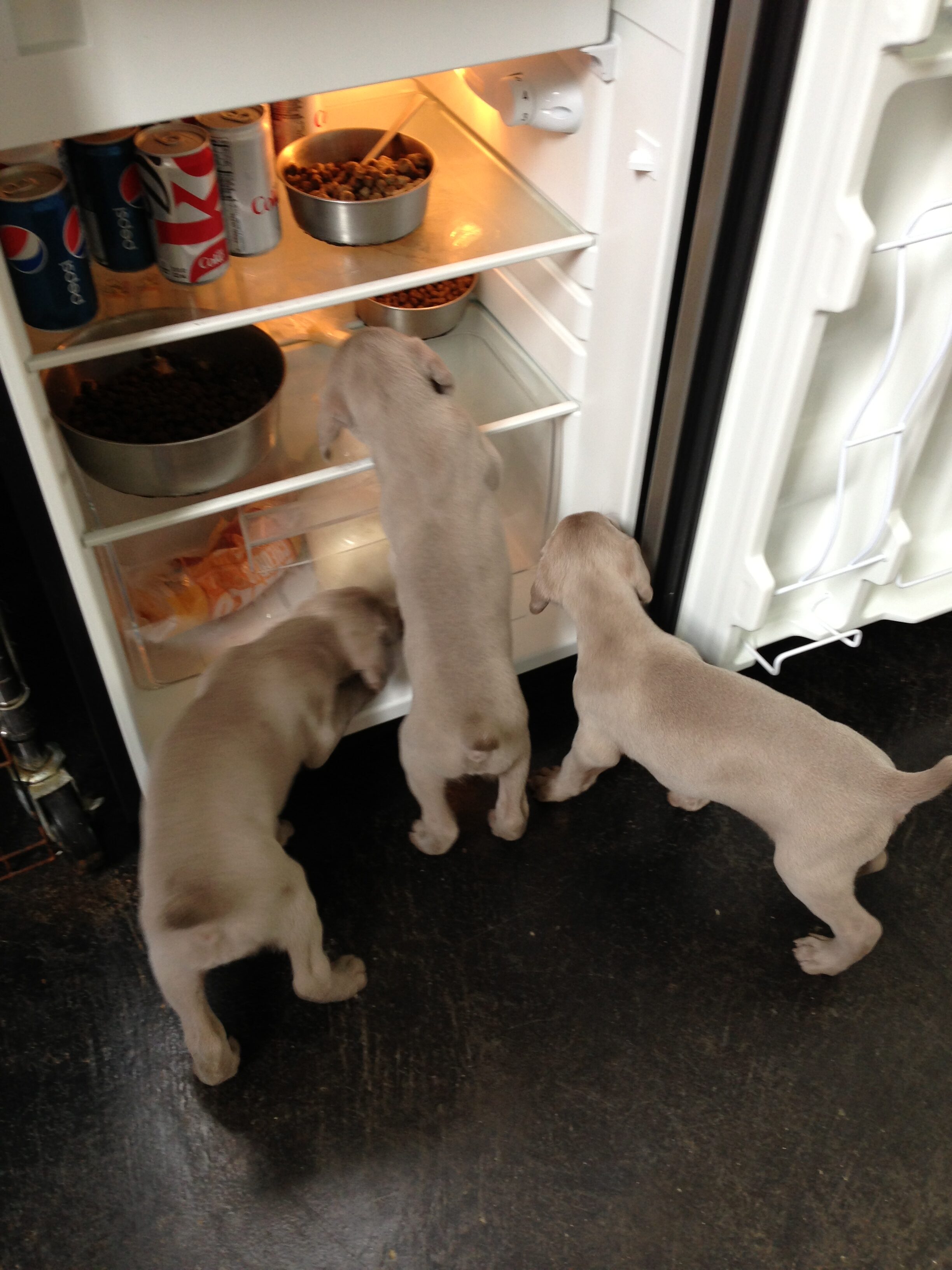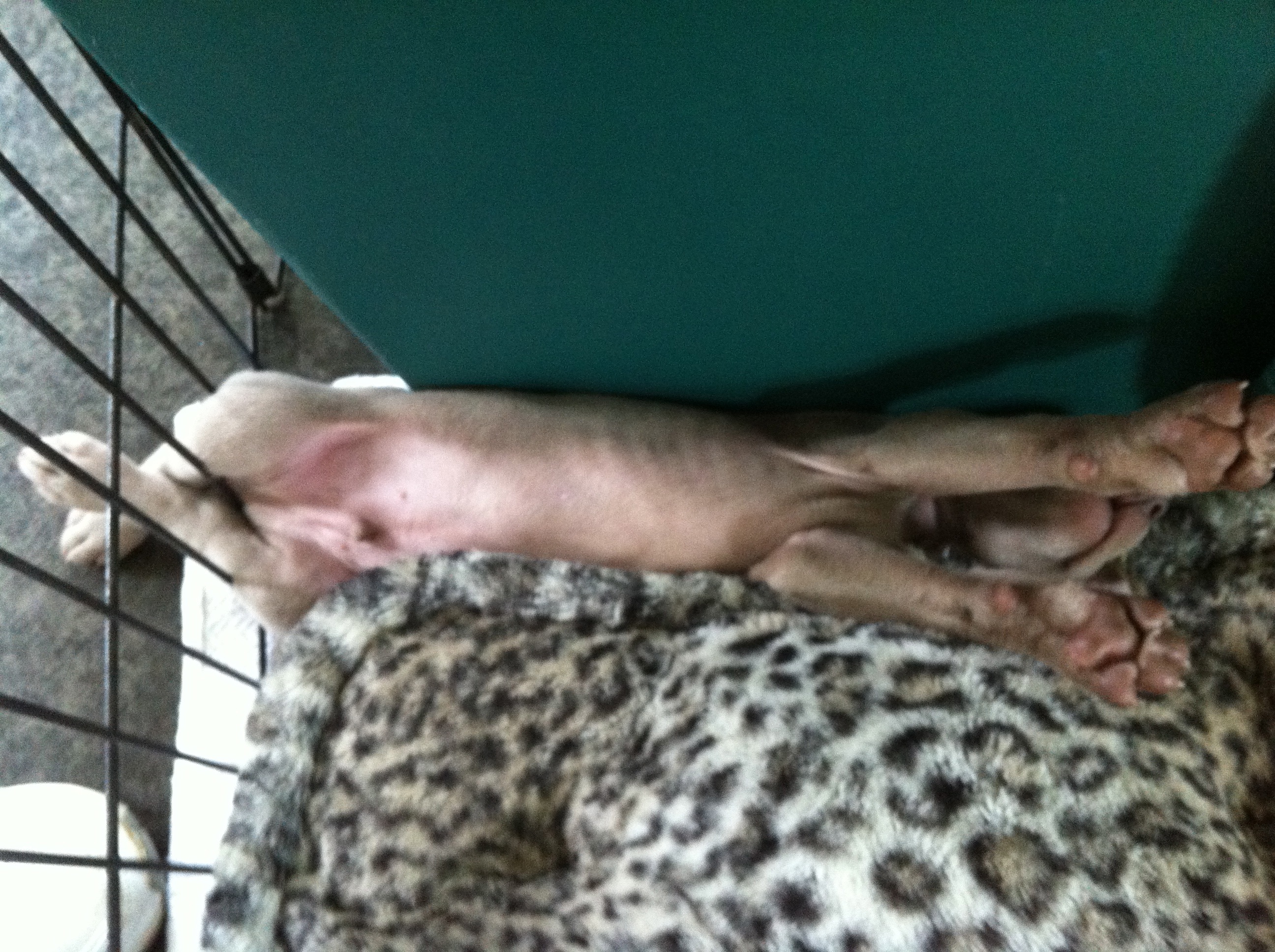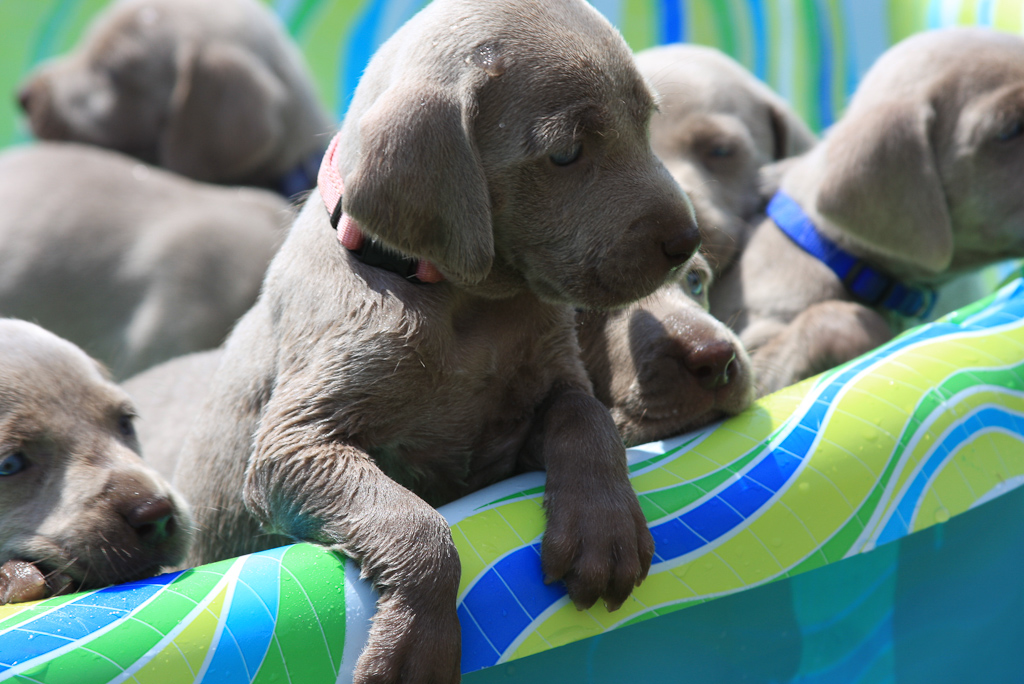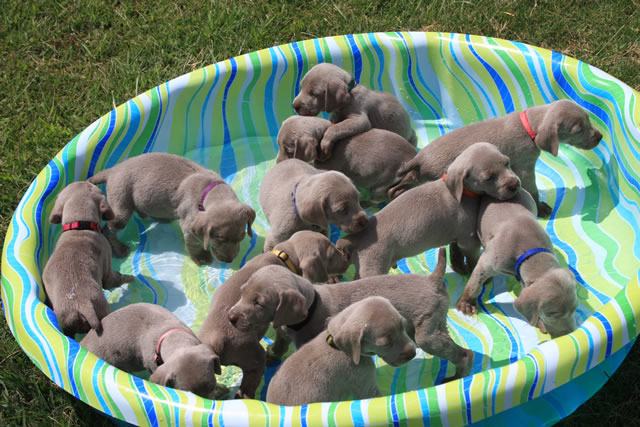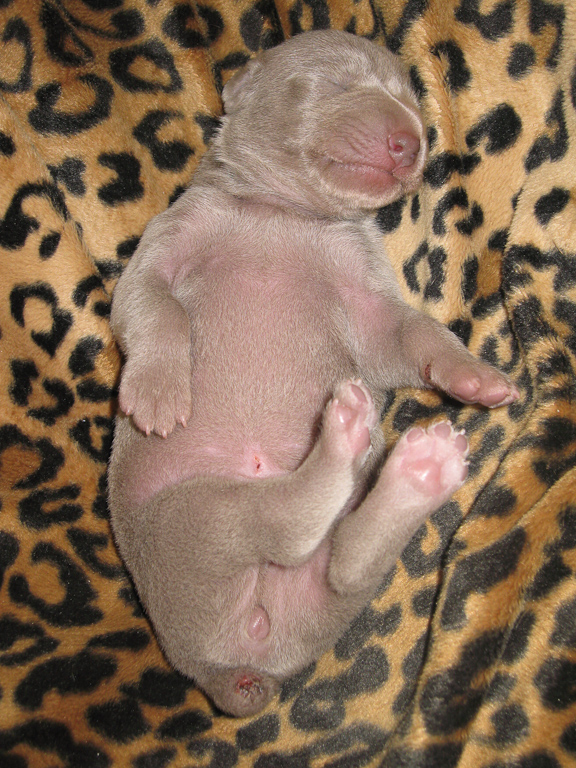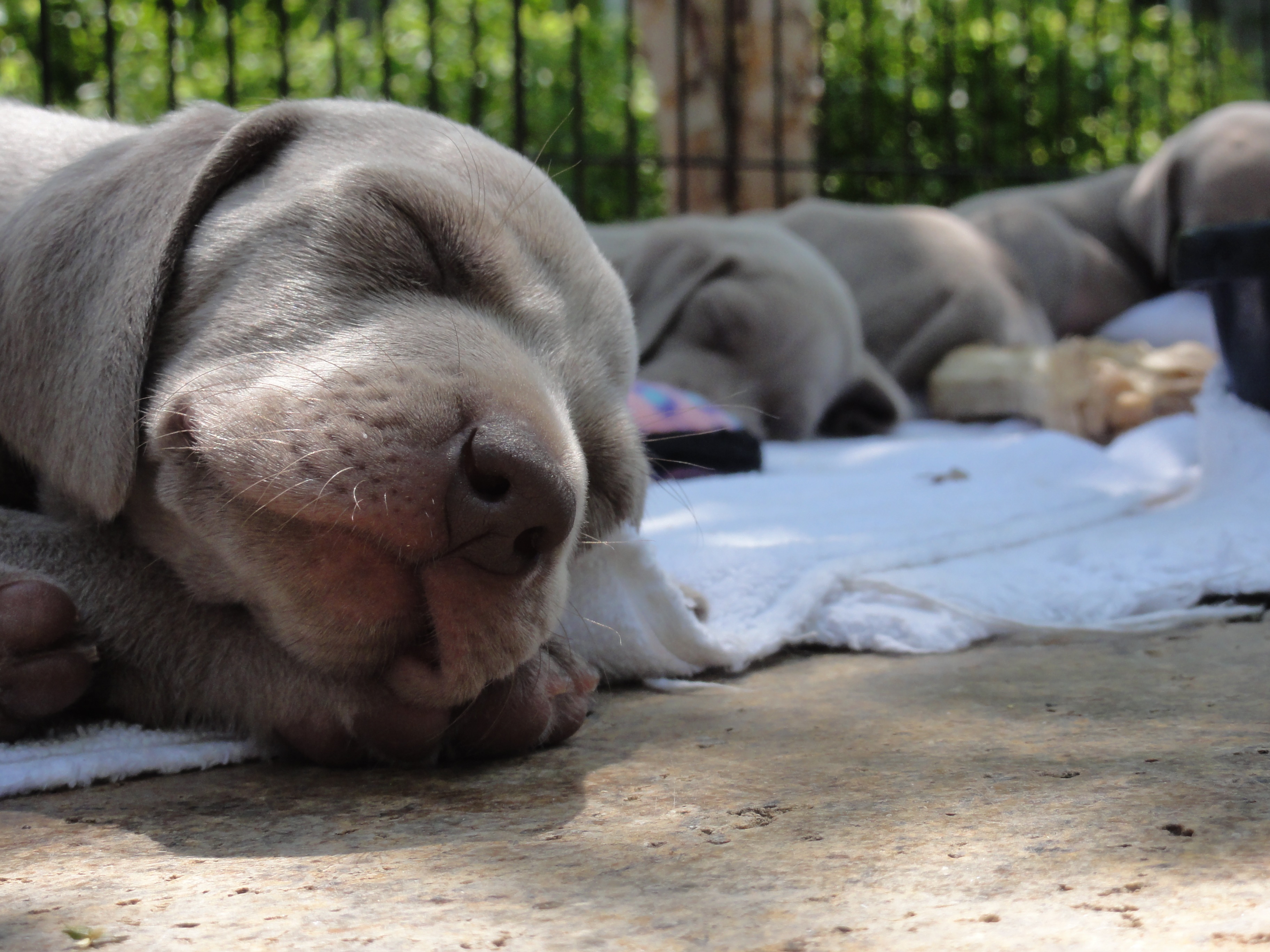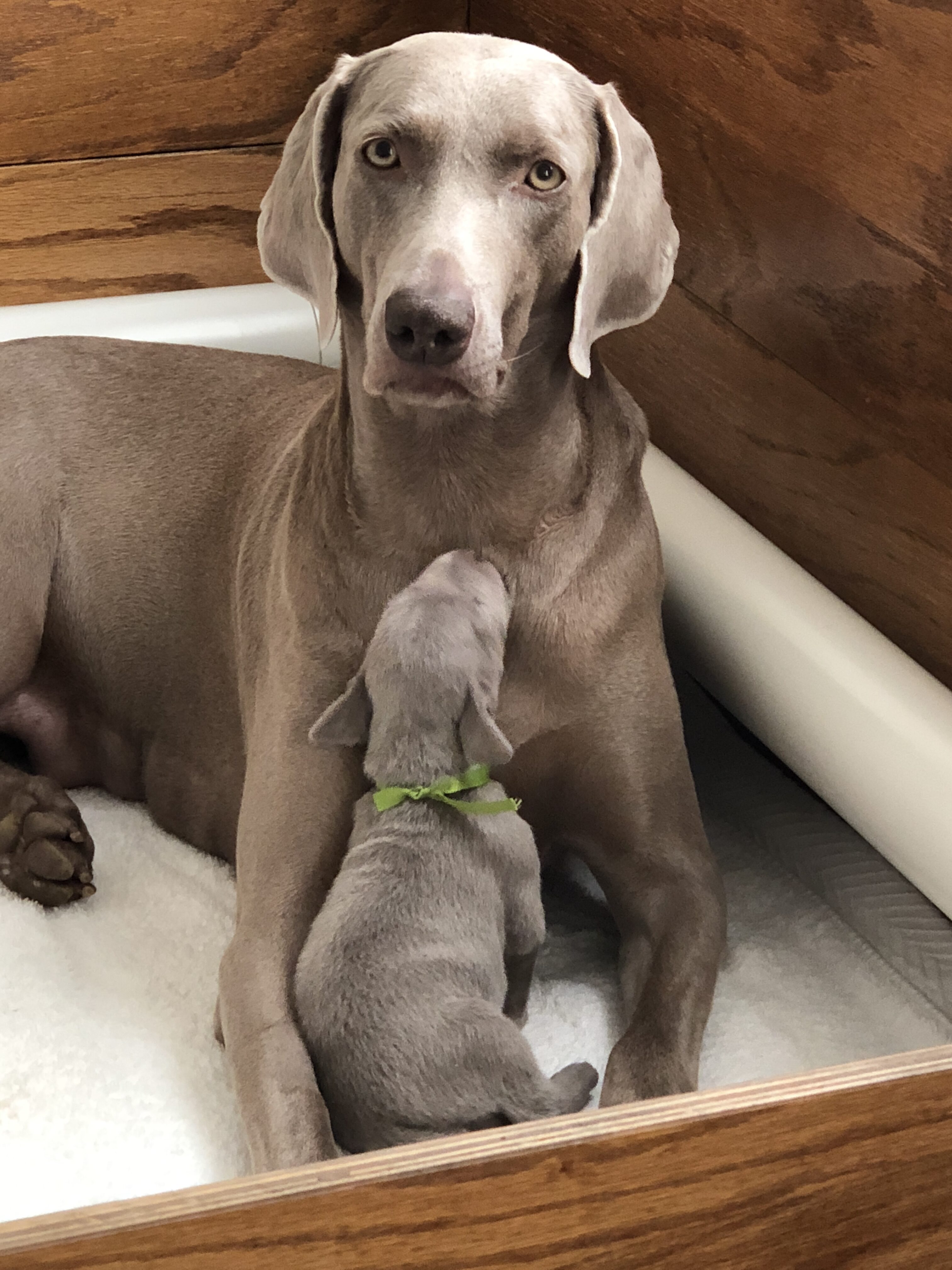Puppy Breath Arriving 2020

Puppy Advice
Providing your puppy or dog with an indoor kennel crate can satisfy many dogs' need for a den-like enclosure. Besides being an effective housebreaking tool (because it takes advantage of the dog's natural reluctance to soil its sleeping place), it can also help to reduce separation anxiety, to prevent destructive behavior (such as chewing furniture), to keep a puppy away from potentially dangerous household items (i.e., poisons, electrical wires, etc.), and to serve as a mobile indoor dog house which can be moved from room to room whenever necessary.
A kennel crate also serves as a travel cabin for you dog when traveling by car or plane. Additionally, most hotels which accept dogs on their premises require them to be crated while in the room to prevent damage to hotel furniture and rugs.
Most dogs which have been introduced to the kennel crate while still young grow up to prefer their crate to rest in or "hang-out" in. Therefore a crate (or any other area of confinement) should NEVER be used for the purpose of punishment.
We recommend that you provide a kennel crate throughout your dog's lifetime. Some crates allow for the removal of the door once it is no longer necessary for the purpose of training. The crate can be placed under a table, or a table top can be put on top of it to make it both unobtrusive and useful.
Preparing the Crate
Vari-Kennel type:
Take the crate apart, removing the screws, the top and the door. Allow your pup to go in and out of the bottom half of the crate before attaching the top half. This stage can require anywhere from several hours to a few days. This step can be omitted in the case of a young puppy who accepts crating right away.
Wire Mesh type:
Tie the crate door back so that it stays open without moving or shutting closed. If the crate comes with a floor pan, place a piece of cardboard or a towel between the floor (or crate bottom) and the floor pan in order to keep it from rattling.
Furnishing Your Puppy's Crate
Toys and Treats:
Place your puppy's favorite toys and dog treats at the far end opposite the door opening. These toys may include the "Tuffy", "Billy", "Kong", "Nylabone" or a ball. Toys and bails should always be inedible and large enough to prevent their being swallowed. Any fragmented toys should be removed to prevent choking and internal obstruction. You may also place a sterilized marrow bone filled with cheese or dog treats in the crate.
Water:
A small hamster-type water dispenser with ice water should be attached to the crate if your puppy is to be confined for more than two hours in the crate.
Bedding:
Place a towel or blanket inside the crate to create a soft, comfortable bed for the puppy. If the puppy chews the towel, remove it to prevent the pup from swallowing or choking on the pieces. Although most puppies prefer lying on soft bedding, some may prefer to rest on a hard, flat surface, and may push the towel to one end of the crate to avoid it. If the puppy urinates on the towel, remove bedding until the pup no longer eliminates in the crate.
Location of Crate
PWhenever possible, place the crate near or next to you when you are home. This will encourage the pup to go inside it without his feeling lonely or isolated when you go out. A central room in the apartment (i.e.: living room or kitchen) or a large hallway near the entrance is a good place to crate your puppy.
Introducing the Crate to Your Puppy
In order that your puppy associate his/her kennel crate with comfort, security and enjoyment, please follow these guidelines:
- ALWAYS take your pup outside to eliminate before being place in the crate AND IMMEDIATELY when exiting after a stay of more than a few minutes. This before and after routing will help minimize soiling in the crate during stays of reasonable length (see duration guidelines below) and will start the training process of getting the pup to “go on command”- an invaluable piece of training for the dog AND owner later in life.
- Occasionally throughout the day, drop small pieces of kibble or dog biscuits in the crate. While investigating his new crate, the pup will discover edible treasures, thereby reinforcing his positive associations with the crate. You may also feed him in the crate to create the same effect. If the dog hesitates, it often works to feed him in front of the crate, then right inside the doorway and then, finally, in the back of the crate.
- In the beginning, praise and pet your pup when he enters. Do not try to push, pull or force the puppy into the crate. At this early stage of introduction only inductive methods are suggested. Overnight exception: You may need to place your pup in his crate and shut the door upon retiring. (In most cases, the crate should be placed next to your bed overnight. If this is not possible, the crate can be placed in the kitchen, bathroom or living room.)
- You may also play this enjoyable and educational game with your pup or dog: without alerting your puppy, drop a small dog biscuit into the crate. Then call your puppy and say to him, "Where's the biscuit? It's in your room." Using only a friendly, encouraging voice, direct your pup toward his crate. When the puppy discovers the treat, give enthusiastic praise. The biscuit will automatically serve as a primary reward. Your pup should be free to leave its crate at all times during this game. Later on, your puppy's toy or ball can be substituted for the treat.
- It is advisable first to crate your pup for short periods of time while you are home with him. In fact, crate training is best accomplished while you are in the room with your dog. Getting him used to your absence from the room in which he is crated is a good first step. This prevents an association being made with the crate and leaving him/her alone.
A Note About Crating Puppies
Puppies under 4 months of age have little bladder or sphincter control. Puppies under 3 months have even less. Very young puppies under 9 weeks should not be crated, as they need to eliminate very frequently (usually 8-12 times or more daily).
Important Reminders
- Collars: Always remove your puppy or dog's collar before confining in the crate. Even flat buckle collars can occasionally get struck on the bars or wire mesh of a crate. If you must leave a collar on the pup when you crate him (e.g.: for his identification tag), use a safety "break away" collar.
- Warm Weather: Do not crate a puppy or dog when temperatures reach an uncomfortable level. This is especially true for the short-muzzled (Pugs, Pekes, Bulldogs, etc.) and the Arctic or thick- coated breeds (Malamutes, Huskies, Akitas, Newfoundlands, etc.). Cold water should always be available to puppies, especially during warm weather. [Never leave an unsupervised dog on a terrace, roof or inside a car during warm weather. Also, keep outdoor exercise periods brief until the hot weather subsides.]
- Be certain that your puppy has fully eliminated shortly before being crated. Be sure that the crate you are using is not too large to discourage your pup from eliminating in it. Rarely does a pup or dog eliminate in the crate if it is properly sized and the dog is an appropriate age to be crated a given amount of time. If your pup/dog continues to eliminate in the crate, the following may be the causes:
- The pup is too young to have much control.
- The pup has a poor or rich diet, or very large meals.
- The pup did not eliminate prior to being confined.
- The pup has worms.
- The pup has gaseous or loose stools.
- The pup drank large amounts of water prior to being crated.
- The pup has been forced to eliminate in small confined areas prior to crate training.
- The pup/dog is suffering from a health condition or illness (i.e., bladder infection, prostate problem, etc.)
- The puppy or dog is experiencing severe separation anxiety when left alone.
Note: Puppies purchased in pet stores, or puppies which were kept solely in small cages or other similar enclosures at a young age (between approximately 7 and 16 weeks of age), may be considerably harder to housebreak using the crate training method due to their having been forced to eliminate in their sleeping area during this formative stage of development. This is the time when most puppies are learning to eliminate outside their sleeping area. Confining them with their waste products retards the housebreaking process, and this problem can continue throughout a dog's adult life
Accidents In The Crate
If your puppy messes in his crate while you are out, do not punish him upon your return. Simply wash out the crate using a pet odor neutralizer (such as Nature's Miracle, Nilodor, or Outright). Do not use ammonia-based products, as their odor resembles urine and may draw your dog back to urinate in the same spot again.
Crating Duration Guidelines
9-10 Weeks Approx. 30-60 minutes
11-14 Weeks Approx. 1-3 hours
15-16 Weeks Approx. 3-4 hours
17 + Weeks Approx. 4+ (6 hours maximum)
*NOTE: Except for overnight, neither puppies nor dogs should be crated for more than 5 hours at a time. (6 hours maximum!)
The Crate As Punishment
NEVER use the crate as a form of punishment or reprimand for your puppy or dog. This simply causes the dog to fear and resent the crate. If correctly introduced to his crate, your puppy should be happy to go into his crate at any time. You may however use the crate as a brief time-out for your puppy as a way of discouraging nipping or excessive rowdiness.
[NOTE: Sufficient daily exercise is important for healthy puppies and dogs. Regular daily walks should be offered as soon as a puppy is fully immunized. Backyard exercise is not enough!]
Children And The Crate
Do not allow children to play in your dog's crate or to handle your dog while he/she is in the crate. The crate is your dog's private sanctuary. His/her rights to privacy should always be respected.
Barking In The Crate
In most cases a pup who cries incessantly in his crate has either been crated too soon (without taking the proper steps as outlined above) or is suffering from separation anxiety and is anxious about being left alone. Some pups may simply under exercised. Others may not have enough attention paid them. Some breeds of dog may be particularly vocal (e.g., Miniature Pinchers, Mini Schnauzers, and other frisky terrier types). These dogs may need the "Alternate Method of Confining Your Dog", along with increasing the amount of exercise and play your dog receives daily.
When Not To Use A Crate
Do not crate your puppy or dog if:
- S/he is too young to have sufficient bladder or sphincter control.
- S/he has diarrhea. Diarrhea can be caused by: worms, illness, intestinal upsets such as colitis, too much and/or the wrong kinds of food, quick changes in the dogs diet, or stress, fear or anxiety.
- S/he is vomiting.
- You must leave him/her crated for more than the Crating Duration Guidelines suggest.
s/he has not eliminated shortly before being placed inside the crate. (See Housetraining Guidelines for exceptions.) - The temperature is excessively high.
- S/he has not had sufficient exercise, companionship and socialization.
Buying a Crate
Where to buy a crate: Crates can be purchased through most pet supply outlets, through pet mail order catalogs and through most professional breeders. Some examples are:
Crate Size and Manufacturers:
Small: (Vari-Kennel #100 or General Cage #201)
Medium Small: (Vari-Kennel #200 or General Cage #202/212)
Medium: (Vari-Kennel #300 or General Cage #203/213)
Large: (Vari-Kennel #400 or General Cage #204/214)
Very Large: (Vari-Kennel #500 or General Cage #205/215)
Extra Large: (General Cage #206 or Mid-West #89-Z, 89-E or 99)
Dog Size:
Toy Poodles, the Maltese, etc., with average weight of 6-10 lbs.
Mini Schnauzers, Jack Russells, etc., with average weight of 11-20 lbs.
Cocker Spaniels, Field Spaniels, small Shelties, etc., with average weight of 21-40 lbs.
Huskies, large Samoyeds, small Golden Retrievers, etc., with average weight of 41-65 Ibs.
German Shepherds, Alaskan Malamutes, Rottweilers, etc., with average weight of 67-100 lbs.
Newfoundlands, Great Danes, etc, with average weight of 110 lbs. plus.
The Cost of A Crate
Crates can cost between $35 and $150 depending on the size and the type of crate and the source.
The Cost of Not Buying a Crate
• Your shoes
• Books
• Table legs;
• Chairs and sofas;
• Throw rugs and carpet, and
• Electric, telephone and computer wires.
The real cost, however, is your dog's safety and your peace of mind.
Alternative Method Of Confining Your Puppy
There are alternative methods to crating very young puppies and puppies who must be left alone in the house for lengths of time exceeding the recommended maximum duration of confinement (see Crating Duration Guidelines). Try the following:
Use a small to medium-sized room space such as a kitchen, large bathroom or hallway with non- porous floor. Set up the crate on one end, the food and water a few feet away, and some newspaper (approx. 2'x3' to 3'x3') using a 3 to 4 layer thickness, several feet away. Confine your puppy to this room or area using a 3 ft. high, safety-approved child's gate rather than shutting off the opening by a solid door. Your pup will feel less isolated if it can see out beyond its immediate place of confinement. Puppy proof the area by removing any dangerous objects or substances and anything you don’t want chewed on!
Immune Mediated Problems and Vaccinations in Weimaraners
A small percentage of Weimaraner puppies exhibit a syndrome following vaccination or other forms of stress. This syndrome can include one or more of the following symptoms:
Hypertrophic Osteodystrophy (swollen and painful joints), Elevated WBC, Elevated temperature, Diarrhea, Lethargy, or Depression, Lymph node enlargement, Pain to touch.
One of the theories to explain this syndrome is the mechanism that shuts off the antigen/antibody response fails to work properly. Most of the problems seen have been in puppies between 12-14 weeks of age. This is the age that maternal antibodies are declining and the immune system is vulnerable to vaccines. The Distemper vaccine has been isolated in the joint fluid of puppies with this condition.
Dr John Angles, University of Dublin Vet. School, Dublin, Ireland and Dr. Niels Pederson, U.C. Davis Vet. School, Davis, Ca. are currently involved in research for this problem funded by the AKC Canine Health Foundation and the Weimaraner Club of America. The ultimate goal is to identify DNA markers for this syndrome.
The recommended treatment is intravenous steroids (dexamethasone) at a loading dose of 0.1-0.5 mg/kg followed by oral prednisone or prednisolone at a dose of 2 mg/kg divided into twice a day dose for one week and then tapered over the next 3-5 weeks to 0.5mg/kg every other day. This treatment reduces the immediate inflammatory response and suppresses the overreacting immune system.
The recommended treatment should be started IMMEDIATELY upon diagnosis. This usually results in rapid recovery. Dr. Angles has found those puppies not treated immediately take LONGER TO RESPOND and a small percentage DO NOT RECOVER.
Although many puppies can be vaccinated with the combination MLV vaccines, there is no way to determine which pups will adversely react. It is recommended that the High Titer Parvo vaccine, which protects with 2 vaccinations be used.
Lyme, Bordetella, and Corona vaccines are NOT recommended unless endemic infection of these diseases are in the area. These should NEVER BE GIVEN IN COMBINATION WITH OTHER VACCINES!!!!
Dr. Angles can be reached at: [email protected] or (530) 754-8728
A medium-sized gray dog, with fine aristocratic features. He should present a picture of grace, speed, stamina, alertness and balance. Above all, the dog’s conformation must indicate the ability to work with great speed and endurance in the field.
Height
Height at the withers: dogs, 25 to 27 inches; bitches, 23 to 25 inches. One inch over or under the specified height of each sex is allowable but should be penalized. Dogs measuring less than 24 inches or more than 28 inches and bitches measuring less than 22 inches or more than 26 inches shall be disqualified.
Head
Moderately long and aristocratic, with moderate stop and slight median line extending back over the forehead. Rather prominent occipital bone and trumpets well set back, beginning at the back of the eye sockets. Measurement from tip of nose to stop equals that from stop to occipital bone. The flews should be straight, delicate at the nostrils. Skin drawn tightly. Neck clean-cut and moderately long. Expression kind, keen and intelligent. Ears–Long and lobular, slightly folded and set high. The ear when drawn snugly alongside the jaw should end approximately 2 inches from the point of the nose. Eyes–In shades of light amber, gray or blue-gray, set well enough apart to indicate good disposition and intelligence. When dilated under excitement the eyes may appear almost black. Teeth–Well set, strong and even; well-developed and proportionate to jaw with correct scissors bite, the upper teeth protruding slightly over the lower teeth but not more than 1/16 of an inch. Complete dentition is greatly to be desired. Nose–Gray. Lips and Gums–Pinkish flesh shades.
Body
The back should be moderate in length, set in a straight line, strong, and should slope slightly from the withers. The chest should be well developed and deep with shoulders well laid back. Ribs well sprung and long. Abdomen firmly held; moderately tucked-up flank. The brisket should extend to the elbow. Coat and Color Short, smooth and sleek, solid color, in shades of mouse-gray to silver-gray, usually blending to lighter shades on the head and ears. A small white marking on the chest is permitted, but should be penalized on any other portion of the body. White spots resulting from injury should not be penalized. A distinctly long coat is a disqualification. A distinctly blue or black coat is a disqualification.
Forelegs
Straight and strong, with the measurement from the elbow to the ground approximately equaling the distance from the elbow to the top of the withers.
Hindquarters
Well-angulated stifles and straight hocks. Musculation well developed.
Feet
Firm and compact, webbed, toes well arched, pads closed and thick, nails short and gray or amber in color. Dewclaws–Should be removed.
Tail
Docked. At maturity it should measure approximately 6 inches with a tendency to be light rather than heavy and should be carried in a manner expressing confidence and sound temperament. A non-docked tail shall be penalized.
Gait
The gait should be effortless and should indicate smooth coordination. When seen from the rear, the hind feet should be parallel to the front feet. When viewed from the side, the topline should remain strong and level.
Temperament
The temperament should be friendly, fearless, alert and obedient.
Faults
Minor Faults–Tail too short or too long. Pink nose.
Major Faults–Doggy bitches. Bitchy dogs. Improper muscular condition. Badly affected teeth. More than four teeth missing. Back too long or too short. Faulty coat. Neck too short, thick or throaty. Low-set tail. Elbows in or out. Feet east and west. Poor gait. Poor feet. Cowhocks. Faulty backs, either roached or sway. Badly overshot, or undershot bite. Snipy muzzle. Short ears.
Very Serious Faults–White, other than a spot on the chest. Eyes other than gray, blue-gray or light amber. Black mottled mouth. Non-docked tail. Dogs exhibiting strong fear, shyness or extreme nervousness.
Disqualifications
Deviation in height of more than one inch from standard either way. A distinctly long coat. A distinctly blue or black coat. Approved December 14, 1971
Weimaraner Club of America Code of Ethics Submitted by the WCA Board of Directors to the membership. This code is established in accordance with the objectives of the Weimaraner Club of America and is set forth as a guideline to protect and advance the interests of the Weimaraner by maintaining high breeding standards and by encouraging sportsmanlike competition at dog shows, field trials, agility trials, obedience trials and tracking tests. Adherence to the code is strongly recommended. BREEDING The breeder will: 1. Breed only with the intention of improving the breed, and of finding suitable homes for the puppies. 2. Choose only healthy parents of good temperament and qualities in relation to the Weimaraner’s AKC approved standard whose hips have been found free of hip dysplasia by a recognized hip registry such as Orthopedic Foundation for Animals or Penn-Hip. Animals under the age of two should have a preliminary hip X-ray or Penn–Hip to evaluate hip status before breeding. 3. Avoid repeatedly using dogs which on multiple occasions and with different mates have produced progeny with life impacting defects or extreme disqualifying faults. 4. Breed only mature bitches with excellent pre-natal and post-natal care for the dam and puppies. 5. Refuse to breed a stud to any female which is markedly inferior physically, mentally or temperamentally. The stud dog owner should be prepared to share the responsibility for placement of the puppies by referring purchasers to the bitch owner and helping with screening homes if necessary. 6. It is the breeder’s responsibility to take back or handle the proper placement of any dog they have produced. HEALTH The owner shall maintain the best possible standards of canine health, cleanliness and veterinary care, including mental health such as contact with people and exposure to the outside world. REGISTRATION The owner shall breed only AKC registered or AKC recognized foreign registered Weimaraners with other AKC registered or AKC recognized foreign registered Weimaraners, and keep accurate records of matings and pedigrees. Use an AKC Limited Registration on all puppies of questionable quality of structure or health, or which should not otherwise be used for breeding. SALES The owner/breeder shall: 1. Not breed, sell or consign puppies or adults to pet shops or other commercial dealers. 2. Screen all prospective new owners to assure that puppies will have a safe and loving home. 3. Urge the new puppy owners to spay or neuter all pets which for any reason will not be used for breeding. Breeders should also provide information on the potential negative impacts of premature sterilization on the late maturing Weimaraner, especially those destined for competitive careers. 4. Use a written contract to clearly explain all expectations for both the breeder and new owner. 5. Honestly evaluate the quality of the Weimaraner sold/placed and fairly represent that evaluation. Not release puppies before they are seven weeks of age and furnish details on feeding, general care, medical inoculations and care, pedigrees, etc. 6. Readily take back or re-home puppies that do not work out for one reason or another. Make every effort in finding a new forever home, even with dogs placed in Rescue programs. 7. Follow up on puppies after placement to insure their continuing care and to encourage the owners to become involved in Weimaraner activities in show, obedience, agility, field and tracking. SPORTSMANSHIP The owner shall always conduct himself in a manner which will reflect credit upon himself, his Weimaraner and the Sport of purebred dogs, regardless of the location or circumstance. Approved December 5, 2008



